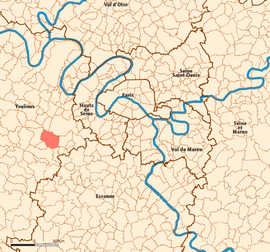Guyancourt
| Guyancourt | ||
|---|---|---|

The Church of Saint-Victor in Guyancourt
|
||
|
||
 Location (in red) within Paris inner and outer suburbs |
||
| Coordinates: 48°46′17″N 2°04′26″E / 48.7714°N 2.0739°ECoordinates: 48°46′17″N 2°04′26″E / 48.7714°N 2.0739°E | ||
| Country | France | |
| Region | Île-de-France | |
| Department | Yvelines | |
| Arrondissement | Versailles | |
| Canton | Montigny-le-Bretonneux | |
| Intercommunality | Saint-Quentin-en-Yvelines | |
| Government | ||
| • Mayor | François Deligné | |
| Area1 | 13.0 km2 (5.0 sq mi) | |
| Population (2006)2 | 28,670 | |
| • Density | 2,200/km2 (5,700/sq mi) | |
| Time zone | CET (UTC+1) | |
| • Summer (DST) | CEST (UTC+2) | |
| INSEE/Postal code | 78297 / 78280 | |
|
1 French Land Register data, which excludes lakes, ponds, glaciers > 1 km² (0.386 sq mi or 247 acres) and river estuaries. 2Population without double counting: residents of multiple communes (e.g., students and military personnel) only counted once. |
||
1 French Land Register data, which excludes lakes, ponds, glaciers > 1 km² (0.386 sq mi or 247 acres) and river estuaries.
Guyancourt (pronounced: [ɡɥi.jɑ̃.kuʁ]) is a commune in the Yvelines department in the Île-de-France region in north-central France. It is located in the south-western suburbs of Paris, 21.2 km (13.2 mi) from the center of Paris, in the "new town" of Saint-Quentin-en-Yvelines.
The commune of Guyancourt comprises several districts. The first of them, corresponding to the old village, is known as "le village", the others are named:
Although located in the Paris suburbs (in an Anglo-Saxon conception of suburbs), more than half of the territory of the commune of Guyancourt is covered in natural spaces: forests, wood, parks, gardens and ponds.
The site of the city was already inhabited by Neolithic tribes who left hundreds of vestiges such as arrows, flint scrapers, polished axes... which have been recovered in the districts of Bouviers, Troux and Villaroy.
The civilization continued through Roman times, as Mr. Leclère, a farmer, demonstrated in a fortuitous way in 1892 by unearthing an antique ballot box in his field.
Work to restore the church Saint-Victor put the date of the sarcophages at the Merovingian era (from the seventh century). It is believed that the construction of the first church dates from the fourteenth century. Several funerary vases and a tomb stone dating from the sixteenth century were updated. The church was renovated in the fifteenth century, then entirely rebuilt in the sixteenth century. The most recent restoration goes back to 1998.
...
Wikipedia

